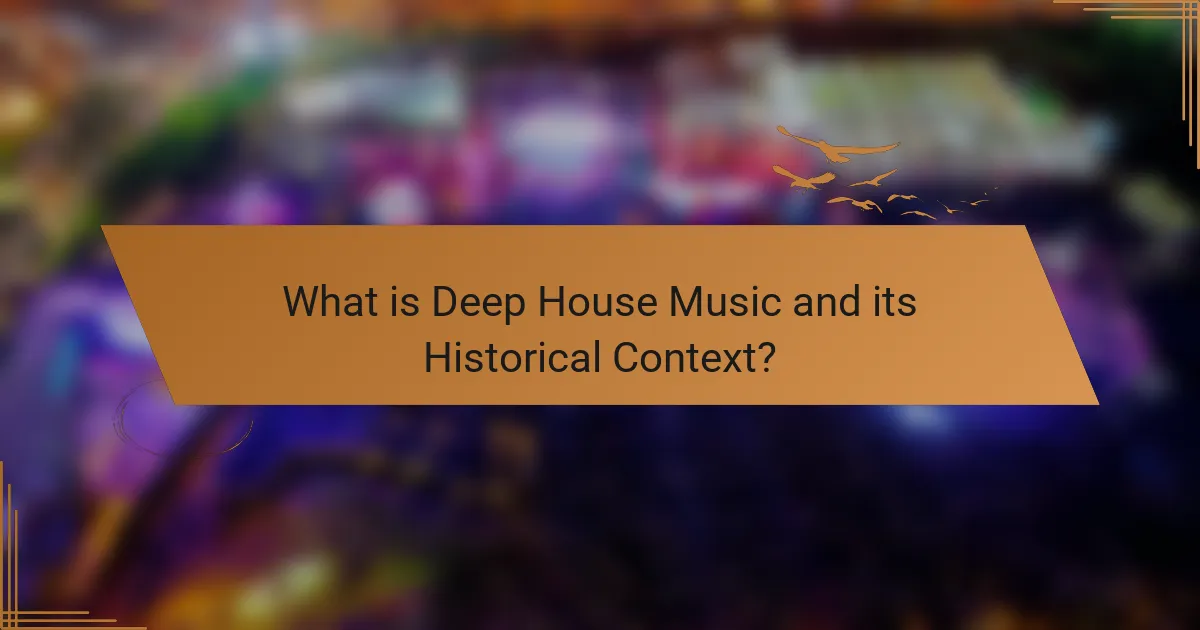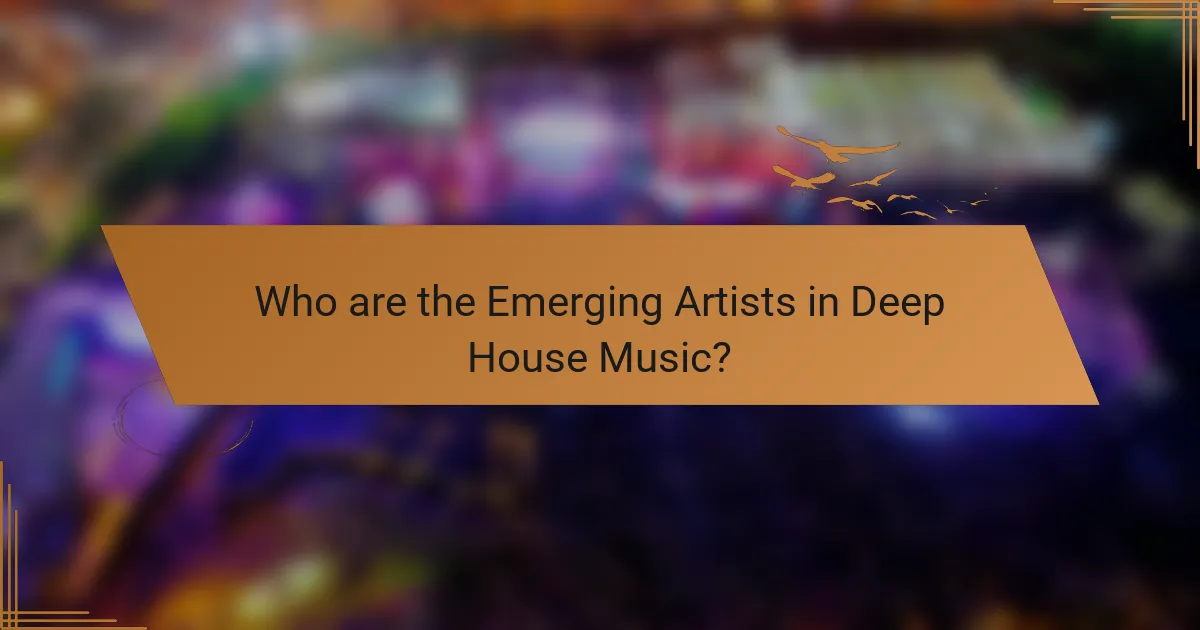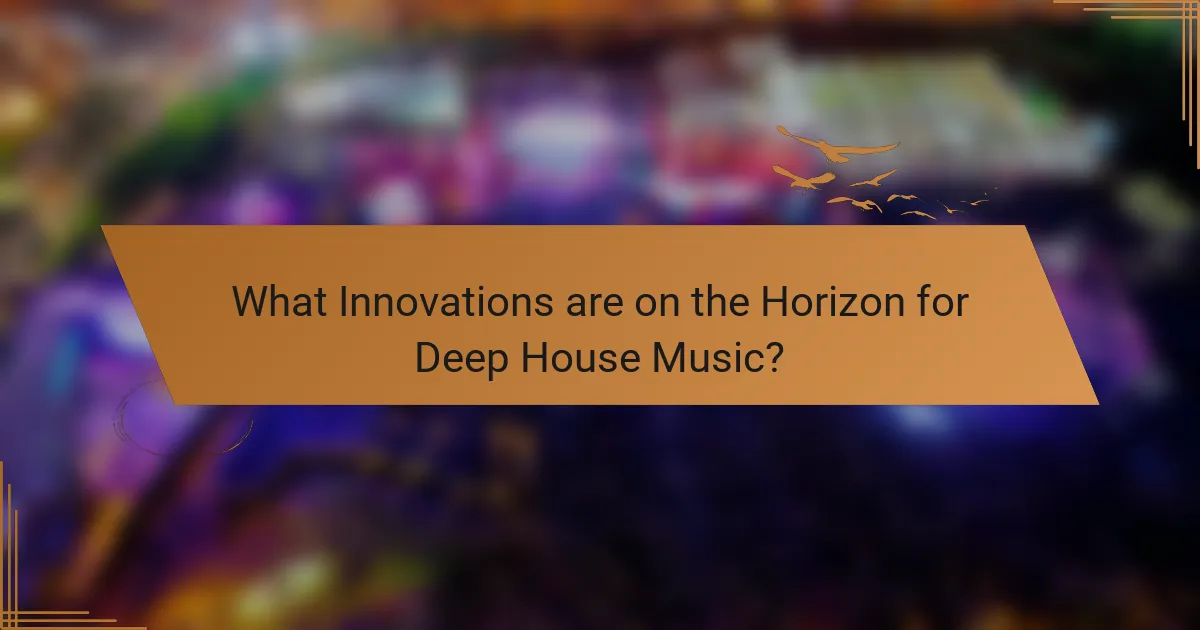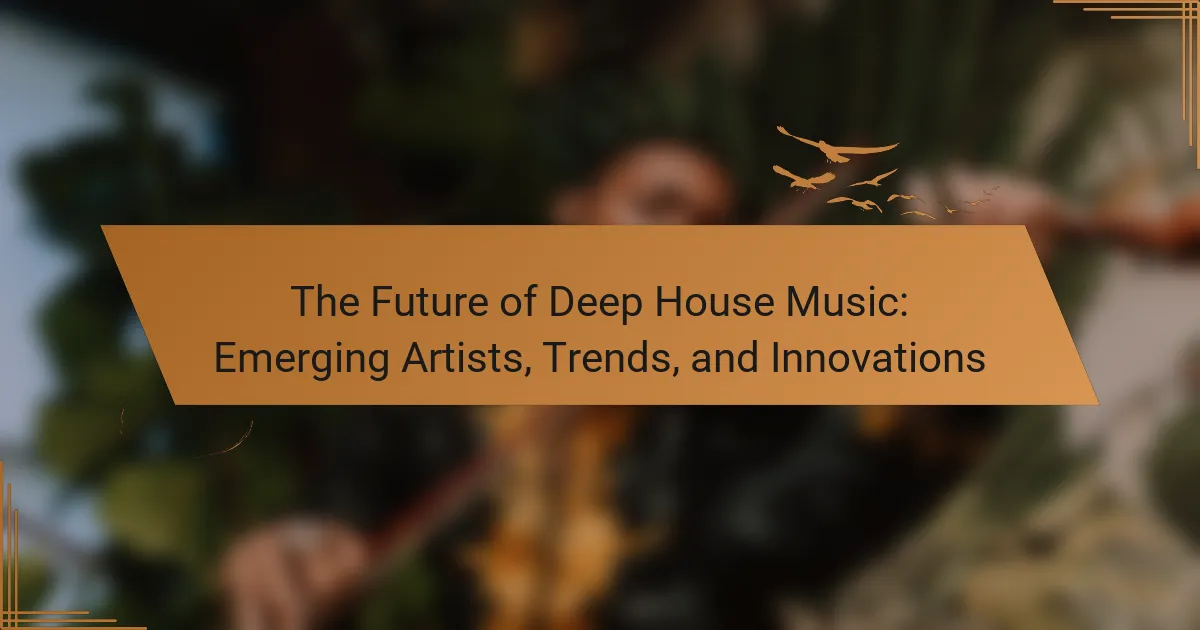Deep house music is a subgenre of house music known for its complex melodies, soulful vocals, and deep basslines, originating in the 1980s in cities like Chicago and New York. The genre gained prominence in the 1990s, especially in Europe, and continues to evolve with influences from jazz, funk, and soul. Emerging artists such as Ben Böhmer, Nora En Pure, Lane 8, and Yotto are shaping the future of deep house by integrating innovative production techniques and live instrumentation. Current trends include the use of diverse vocal samples and immersive soundscapes, while advancements in technology, such as AI-driven tools and virtual reality experiences, are set to redefine the genre’s landscape.

What is Deep House Music and its Historical Context?
Deep house music is a subgenre of house music characterized by its complex melodies, soulful vocals, and deep basslines. It emerged in the 1980s, primarily in Chicago and New York City. Influences include jazz, funk, and soul music. Pioneering artists like Larry Heard and Frankie Knuckles contributed significantly to its development. The genre gained popularity in the 1990s, particularly in Europe. Deep house is known for its atmospheric soundscapes and slower tempos. It continues to evolve, integrating elements from various electronic music styles. Today, deep house remains a prominent genre in clubs and festivals worldwide.
How did Deep House Music evolve over the years?
Deep House Music evolved significantly from the 1980s to the present day. Initially, it emerged from Chicago house music, characterized by its soulful vocals and jazzy elements. The genre gained popularity in the 1990s with artists like Larry Heard and Frankie Knuckles. By the early 2000s, Deep House incorporated more electronic sounds and minimalistic beats. The rise of digital music platforms in the 2010s further expanded its reach. Contemporary artists blend various genres, integrating pop and techno influences. Festivals and clubs now showcase Deep House, contributing to its mainstream acceptance. Today, it continues to evolve with emerging artists pushing creative boundaries.
What key influences shaped the sound of Deep House Music?
Deep House Music is shaped by several key influences. These include Chicago house, soul music, and jazz. Chicago house laid the foundation with its repetitive beats and synthesized sounds. Soul music contributed emotional depth and vocal styles. Jazz introduced complex harmonies and improvisational elements. The combination of these genres created a unique sound profile. Additionally, the use of technology, such as synthesizers and drum machines, further defined the genre. The influence of artists like Larry Heard and Frankie Knuckles is also significant. Their innovative approaches helped to popularize Deep House in the 1980s and 1990s.
Which artists were pivotal in the development of Deep House Music?
Larry Heard, also known as Mr. Fingers, was pivotal in the development of Deep House Music. He produced influential tracks like “Can You Feel It” in 1986. His work emphasized melody and atmosphere, setting a foundation for the genre. Frankie Knuckles, known as the “Godfather of House,” also played a crucial role. His remixes and productions shaped the sound of Deep House in the 1980s. Another key figure is Kerri Chandler, who introduced soulful elements to the genre. His tracks often featured rich vocals and deep basslines. These artists collectively contributed to the establishment and evolution of Deep House Music. Their influence is still felt in contemporary productions.
What defines the sound and style of Deep House Music?
Deep House Music is defined by its smooth, soulful sound and deeper basslines. It typically features slower tempos, ranging from 120 to 125 BPM. The genre is characterized by melodic elements and atmospheric pads. Vocals in deep house are often soft and emotive, adding to the overall vibe. The use of jazz, funk, and soul influences is prevalent in the arrangements. Deep house tracks frequently incorporate complex chord progressions and layered instrumentation. Its roots trace back to the Chicago house scene in the 1980s. This genre has evolved with technology, embracing modern production techniques while maintaining its signature style.
What are the typical musical elements of Deep House Music?
Deep House Music typically features smooth, soulful melodies and a steady, laid-back tempo. The genre is characterized by deep basslines that provide a rich foundation. Additionally, the use of atmospheric pads creates a lush soundscape. Vocal samples, often soulful or jazzy, enhance the emotional depth of the tracks. Percussion elements are usually minimal and groovy, contributing to the overall chill vibe. The incorporation of jazz and funk influences is also common, adding complexity to the musical structure. These elements combine to create a unique sound that is both relaxing and danceable.
How do tempo and rhythm contribute to the Deep House genre?
Tempo and rhythm are fundamental to the Deep House genre. Deep House typically features a tempo ranging from 120 to 125 beats per minute. This moderate tempo creates a relaxed yet danceable groove. Rhythm in Deep House is characterized by syncopated basslines and intricate drum patterns. These rhythmic elements contribute to the genre’s smooth and immersive quality. The use of off-beat hi-hats and percussive elements enhances the overall texture of the music. Together, tempo and rhythm establish the signature soulful vibe that Deep House is known for. This combination allows for emotional expression while maintaining an engaging dance atmosphere.

Who are the Emerging Artists in Deep House Music?
Emerging artists in deep house music include artists like Ben Böhmer, who blends melodic elements with deep basslines. Another notable artist is Nora En Pure, known for her organic sounds and uplifting vibes. Additionally, artists such as Lane 8 and Yotto are gaining recognition for their unique styles. These artists are contributing to the evolution of deep house music. They are known for their innovative production techniques and engaging live performances. Their music often features rich textures and emotive melodies. This trend reflects a growing interest in deeper, more immersive listening experiences.
What new talents are currently making waves in Deep House Music?
Emerging talents making waves in Deep House Music include artists like Anjunadeep’s Ben Böhmer and Nora En Pure. Ben Böhmer is known for his melodic soundscapes and has gained significant attention with tracks like “Breathing.” Nora En Pure blends deep house with elements of indie and has captivated audiences with her hit “Come With Me.” Additionally, artists like DJ Seinfeld and Yotto are also rising stars, pushing boundaries within the genre. Their innovative sounds and unique styles are reshaping the Deep House landscape.
Which emerging artists have gained significant recognition recently?
Emerging artists gaining significant recognition recently in deep house music include LP Giobbi, who has been praised for her innovative sound and energetic performances. Another notable artist is Mochakk, known for his unique blend of deep house and techno, which has garnered attention on major music platforms. Additionally, the duo Bicep continues to rise in prominence with their captivating live shows and critically acclaimed releases. These artists have been featured in prominent music festivals and playlists, showcasing their growing influence in the genre.
How are these artists innovating within the genre?
These artists are innovating within the deep house genre by blending diverse musical influences. They incorporate elements from genres such as jazz, funk, and ambient music. This fusion creates unique soundscapes that distinguish their work. Many artists are also utilizing advanced technology in music production. They experiment with AI-generated sounds and virtual instruments. This approach enhances creativity and pushes sonic boundaries. Additionally, collaborations with visual artists are becoming common. These partnerships create immersive experiences that engage multiple senses. Overall, these innovations are reshaping the deep house landscape and attracting new audiences.
What platforms are supporting emerging Deep House artists?
SoundCloud, Bandcamp, and Spotify are key platforms supporting emerging Deep House artists. SoundCloud allows artists to upload and share their music easily. Bandcamp offers a direct-to-fan sales model, enabling artists to sell their tracks and merchandise. Spotify provides playlists that feature new Deep House artists, increasing their visibility. These platforms collectively help artists reach wider audiences and gain recognition in the music industry.
How do streaming services influence the rise of new artists?
Streaming services significantly influence the rise of new artists by providing accessible platforms for music distribution. These platforms allow artists to reach global audiences without traditional gatekeepers. For instance, Spotify’s algorithm promotes new music through curated playlists, increasing exposure. In 2020, Spotify reported that over 60,000 new tracks were uploaded daily. This vast volume creates opportunities for emerging artists to be discovered. Additionally, streaming services collect data on listener preferences, helping artists tailor their music and marketing strategies. Platforms like SoundCloud have also enabled artists to share their work directly with fans, fostering community engagement. The ease of access and data-driven insights empower new artists to build their careers effectively in a competitive landscape.
What role do social media and online communities play in artist promotion?
Social media and online communities significantly enhance artist promotion. They provide platforms for artists to share their work directly with audiences. This direct interaction fosters a sense of community and engagement. Artists can showcase new music, receive immediate feedback, and build a loyal fanbase. Statistics show that 90% of marketers believe social media is essential for brand awareness. Additionally, platforms like Instagram and TikTok have become vital for music discovery. Many emerging artists gain recognition through viral trends on these sites. Online communities also offer networking opportunities with other artists and industry professionals. This interconnectedness amplifies promotional efforts and increases visibility for emerging talents in the deep house music scene.

What are the Current Trends in Deep House Music?
Current trends in deep house music include the integration of live instrumentation and organic sounds. Artists are increasingly blending electronic elements with acoustic instruments. This trend enhances the depth and texture of tracks. Another trend is the use of vocal samples from diverse genres. This approach adds a unique flavor to deep house tracks. Additionally, there is a growing emphasis on production techniques that create immersive soundscapes. Artists are focusing on atmospheric elements to engage listeners. Collaborations between established and emerging artists are also on the rise. This trend fosters innovation and cross-genre experimentation. Lastly, the incorporation of technology, such as AI in music production, is gaining traction. These trends reflect the evolving nature of deep house music.
How are technological advancements shaping Deep House Music?
Technological advancements are significantly shaping Deep House Music by enhancing production techniques and accessibility. Digital audio workstations (DAWs) allow artists to create complex sounds with ease. Software plugins provide a vast array of effects and instruments, expanding creative possibilities. Cloud-based collaboration tools enable artists to work together remotely, fostering innovation. Streaming platforms have democratized music distribution, giving emerging artists wider reach. Artificial intelligence is being used to analyze trends and assist in music creation. High-quality audio equipment has become more affordable, improving sound quality for both creators and listeners. These advancements collectively influence the evolution of Deep House Music.
What innovations in production techniques are becoming popular?
Innovations in production techniques for deep house music include the use of AI-assisted music composition tools. These tools analyze existing tracks to generate new melodies and harmonies. Additionally, modular synthesizers are gaining popularity for their versatility and unique sound design capabilities. Producers are also increasingly using spatial audio technology to create immersive listening experiences. The integration of cloud-based collaboration platforms allows artists to work together remotely and efficiently. Finally, live coding is emerging as a method for real-time music creation during performances. These trends reflect a shift towards more experimental and collaborative approaches in music production.
How is the use of virtual reality and immersive experiences evolving the genre?
The use of virtual reality and immersive experiences is transforming the deep house music genre significantly. Artists are now creating virtual concerts that allow fans to experience music in a fully immersive environment. This technology enhances audience engagement and interaction during live performances. For instance, platforms like VRChat host virtual events where users can dance and socialize in 3D spaces.
Additionally, virtual reality enables artists to visualize their music through stunning graphics and animations. This creates a multisensory experience that deepens emotional connections with the audience. According to a report by the International Music Summit, 70% of artists believe that virtual reality will shape the future of live music experiences.
Furthermore, immersive experiences are also being used for music production. Artists can collaborate in virtual studios, breaking geographical barriers. This evolution reflects a broader trend of integrating technology into music, making deep house more accessible and innovative.
What cultural influences are impacting Deep House Music today?
Deep House Music today is influenced by various cultural elements. The rise of digital technology has democratized music production. This allows artists from diverse backgrounds to create and share their work. Globalization has also played a significant role. Artists are blending traditional sounds from their cultures with modern electronic music.
The influence of social media is evident in how music is promoted and consumed. Platforms like SoundCloud and Instagram help emerging artists gain visibility. Furthermore, the resurgence of vinyl culture is impacting the aesthetic and authenticity of Deep House.
Collaborations between genres, such as jazz and soul, enrich the sound of Deep House. Events like festivals and underground parties foster community and cultural exchange. The growing interest in wellness and mindfulness has led to more introspective and ambient Deep House tracks.
These cultural influences shape the evolution and accessibility of Deep House Music today.
How are global sounds being integrated into Deep House Music?
Global sounds are integrated into Deep House Music through the incorporation of diverse musical elements and cultural influences. Artists blend traditional instruments and rhythms from various cultures with electronic beats. This fusion creates a rich auditory experience that transcends geographical boundaries. For instance, Afro-house incorporates African percussion and melodies, while Latin-inspired deep house features bossa nova and salsa elements. The use of samples from global music archives also enhances this integration. Collaborations between artists from different cultural backgrounds further enrich the genre. As a result, Deep House Music reflects a globalized musical landscape, appealing to a wider audience. This trend aligns with the growing demand for diverse musical experiences in contemporary music.
What role does diversity play in the future of Deep House Music?
Diversity plays a crucial role in shaping the future of Deep House Music. It fosters innovation by bringing together various cultural influences. Different backgrounds contribute unique sounds and rhythms to the genre. This blend enhances creativity and broadens the appeal of Deep House Music. Artists from diverse communities introduce fresh perspectives and storytelling techniques. Events and festivals increasingly celebrate this diversity, attracting wider audiences. The incorporation of varied musical styles can lead to new sub-genres. Overall, diversity enriches the scene and ensures its evolution.

What Innovations are on the Horizon for Deep House Music?
Innovations on the horizon for deep house music include advancements in technology and production techniques. AI-driven music creation tools are becoming more prevalent. These tools allow artists to experiment with new sounds and compositions. Virtual reality experiences for live performances are also emerging. They provide immersive environments for audiences. Enhanced collaboration platforms are facilitating remote teamwork among artists. This enables diverse influences to merge in new tracks. Additionally, the integration of sustainable practices in music production is gaining traction. This trend reflects a growing awareness of environmental issues. Overall, these innovations are set to redefine the deep house music landscape.
How are collaborations influencing the future of Deep House Music?
Collaborations are significantly influencing the future of Deep House Music. They bring together diverse musical styles and cultural influences. This fusion creates innovative sounds that attract a broader audience. Collaborations often involve artists from different genres, enhancing creativity. For instance, combining Deep House with elements of pop or hip-hop can lead to fresh tracks. Additionally, collaborations can increase visibility for emerging artists. They often gain exposure through established names in the industry. The rise of digital platforms facilitates these partnerships. Artists can easily connect and collaborate globally, expanding their reach. Overall, collaborations are shaping a more dynamic and inclusive Deep House scene.
What cross-genre collaborations are emerging in the Deep House scene?
Cross-genre collaborations in the Deep House scene are increasingly blending elements from genres like techno, jazz, and pop. Artists are experimenting with diverse sounds to create unique tracks. For example, collaborations between Deep House producers and live musicians are becoming common. This fusion often incorporates live instruments, enhancing the depth of the music. Additionally, vocalists from various genres are lending their voices to Deep House tracks. This trend introduces new lyrical themes and styles. Collaborations with techno artists are particularly notable, merging rhythmic intensity with melodic elements. These cross-genre efforts reflect a broader trend of genre fluidity in contemporary music.
How do these collaborations expand the audience for Deep House Music?
Collaborations expand the audience for Deep House Music by blending genres and attracting diverse listeners. When artists from various musical backgrounds collaborate, they introduce their fan bases to Deep House. This cross-pollination increases exposure and interest in the genre. For instance, collaborations with pop or hip-hop artists can draw in listeners who may not typically engage with Deep House. Additionally, these partnerships often result in tracks that receive radio play and streaming platform features. This wider reach on popular platforms further amplifies the genre’s visibility. Consequently, collaborations serve as a strategic tool for Deep House artists to broaden their audience.
What can listeners expect from the future of Deep House Music?
Listeners can expect a blend of innovative sounds and collaborations in the future of Deep House Music. Emerging artists are increasingly experimenting with diverse genres. This includes incorporating elements from techno, jazz, and ambient music. The use of advanced production techniques is also on the rise. This trend enhances the depth and complexity of tracks. Additionally, live performances are evolving with more interactive experiences. Listeners may see more immersive visuals and technology integration. The community around Deep House is expanding globally, leading to more cultural influences. These factors indicate a dynamic future for Deep House Music.
How will the sound of Deep House Music evolve in the next few years?
The sound of Deep House Music will evolve by incorporating more diverse genres. Artists will blend elements from techno, jazz, and ambient music. This fusion will create richer, more complex soundscapes. Additionally, advancements in technology will influence production techniques. Enhanced software will allow for greater experimentation with sound design. The use of AI in music creation will also emerge, leading to innovative compositions. Collaborations between established and emerging artists will push boundaries further. Increased global influences will shape the genre’s evolution, reflecting cultural diversity. Overall, the sound will become more eclectic and experimental in the coming years.
What are the potential challenges facing the Deep House genre moving forward?
The Deep House genre faces several potential challenges moving forward. One challenge is market saturation, as numerous artists are entering the scene. This oversupply can dilute the unique sound of Deep House. Another challenge is the evolving musical tastes of listeners. Audiences may shift towards other genres, impacting Deep House’s popularity. Additionally, technological advancements can create a barrier. New production techniques may favor genres with more mainstream appeal. The genre also struggles with visibility in mainstream media. Limited radio play and festival representation can hinder its growth. Lastly, the rise of digital platforms raises competition. Emerging genres can quickly capture listener attention, making it difficult for Deep House to maintain its audience.
What are some tips for discovering new Deep House Music?
Explore music streaming platforms like SoundCloud and Spotify. These platforms often feature new and emerging artists. Follow curated playlists focused on deep house music. These playlists are updated regularly with fresh tracks. Join online communities and forums dedicated to deep house music. Engaging with enthusiasts can lead to discovering hidden gems. Attend local events or clubs that showcase deep house DJs. Live performances often introduce new music not found online. Utilize social media to follow deep house artists and labels. Artists frequently share their latest releases and influences. Listen to music blogs and podcasts that specialize in deep house. These sources provide insights into trends and new releases.
Which platforms are best for finding emerging Deep House artists?
SoundCloud is a leading platform for discovering emerging Deep House artists. It features user-uploaded tracks and allows for easy sharing and collaboration. Many new artists use SoundCloud to showcase their music. The platform’s algorithm also recommends tracks based on user preferences. Bandcamp is another excellent platform for finding new Deep House talent. It allows artists to sell their music directly to fans. This model supports independent artists and promotes unique sounds. Additionally, Spotify offers curated playlists focused on Deep House. These playlists often include up-and-coming artists alongside established names. Lastly, social media platforms like Instagram and TikTok are vital for artist discovery. Artists often promote their work through engaging content on these platforms.
How can listeners stay updated on the latest trends in Deep House Music?
Listeners can stay updated on the latest trends in Deep House Music by following dedicated music blogs and websites. Platforms like Resident Advisor and Mixmag regularly publish articles on emerging artists and trends. Social media platforms, especially Instagram and Twitter, are valuable for real-time updates. Following prominent DJs and producers can provide insights into new releases and events. Streaming services like Spotify and SoundCloud curate playlists that highlight current Deep House tracks. Additionally, attending music festivals and local events allows listeners to experience the genre live and discover new artists. Engaging in online forums and communities focused on Deep House can also facilitate discussions on trends and innovations.
Deep house music is a subgenre of house music known for its complex melodies, soulful vocals, and deep basslines, originating in the 1980s from Chicago and New York City. The article explores the historical context of deep house, its evolution over the years, and key influences from genres like jazz, funk, and soul. It highlights pivotal artists who shaped the genre, current trends including the integration of live instrumentation and technology, and the emerging talents that are innovating within the scene. Additionally, the article discusses the impact of streaming platforms and social media on artist promotion and the future challenges and opportunities facing deep house music.
